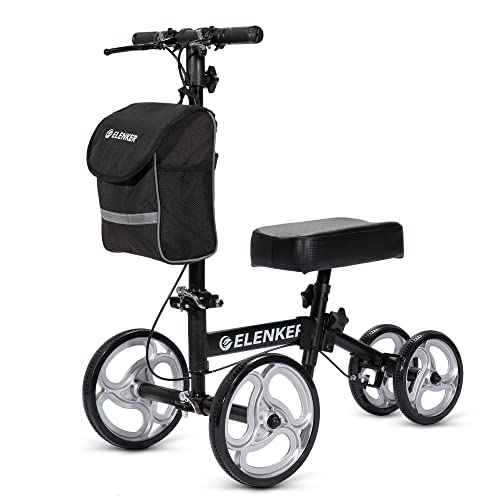Mobility scooters help older adults and people with disabilities retain their independence, and they’re surprisingly affordable. However, scooters vary greatly in features and capabilities, and first-time buyers often feel (understandably) overwhelmed by the options.
We researched some of the best mobility scooters available, comparing features that could affect their real-world usability. Here’s our list of the best scooters currently available online. We’ve also included a detailed buying guide at the end of this list.
The best mobility scooters
Vive 3-Wheel Mobility Scooter

Safely navigate smooth surfaces with the Vive 3-Wheel Mobility Scooter. This comfortable scooter features easy grip tires that are non-marking to protect your surfaces. The scooter can be quickly disassembled into four pieces for easy portability so you can take this scooter on the go.
We especially like the comfortable swivel seating which rotates so it’s safer and easier to step off the scooter without impacting your back. The 16.9″ seat is cushy and comfortable and a wide backrest provides even more support.
The scooter also features an intuitive control panel where you can set a maximum speed, turn on a headlight, check the battery life, and more safety features.
Pros
- Swivel seat for easily getting on and off of the scooter
- Intuitive control panel for enabling safety settings
- Storage basket for easy transport of your belongings
Cons
- Some users noted this model didn’t do as well on uneven terrain
Key Features
- Padded seat and backrest
- Disassembles into 4 pieces for transport
- Padded armrests that can be flipped upward when getting on and off
- Quick connect battery for easy charging
- 8″ wheels
Specifications
- Brand: Vive
- Product Weight: 84 pounds
- Weight Capacity: 265 pounds
ELENKER Steerable Knee Walker Deluxe Medical Scooter


This ELENKER knee scooter features a contoured, memory foam knee rest that helps easily distribute pressure for a more comfortable experience. The scooter has 8-inch PVC wheels that are ideal for many surface types as well as locking hand brakes. The handlebars and knee pad are easily adjustable to a wide range of user heights.
Like other models in our review, this scooter features a quick release fold for easy storage or transport. We also like that this scooter comes with a storage basket so you can be focused on moving safely and not trying to carry your belongings.
Pros
- Contoured pad helps relieve pressure on your knee
- Storage basket for easy transport of your belongings
Cons
- Some users noted this model didn’t do as well on uneven terrain
Key Features
- Memory foam knee pad
- Quick release folding mechanism
- Locking brakes
- Adjustable height handlebars and knee pad
- 8″ PVC wheels
Specifications
- Brand: ELENKER
- Product Weight: 23.37 pounds
- Weight Capacity: 300 pounds
Our Best Mobility Scooters Guide
Before purchasing a powered mobility scooter, determine a budget and consider the user’s mobility challenges. Some older adults might simply need a knee walker or wheelchair—and some might strongly prefer those options. If you’re buying for another person, discuss the purchase with them before making a commitment.
With that said, if you decide on a powered scooter, here are some important factors to consider:
3-Wheel Versus 4-Wheel Models
While three-wheel mobility scooters have a tighter turning radius, there’s a predictable tradeoff: They’re slightly harder to keep balanced, which can be an issue for older adults with high fall risks.
Well-coordinated users won’t have much of an issue, but if you’re purchasing a mobility scooter for use on uneven terrain, a four-wheel option might be a safer choice.
Range and Maximum Speed
Range is an especially important consideration for older adults who intend to use mobility scooters on an everyday basis. All powered mobility scooter manufacturers list an approximate maximum range, but understand that these ranges are estimates; factors that affect range include the user’s bodyweight, the age of the battery, and the speed of the scooter during operation.
Likewise, the scooter’s maximum speed will depend on the user’s weight and the operating conditions (all mobility scooters will slow down slightly when going up an incline, for instance). Don’t worry too much about maximum speed unless you have a specific reason to do so—the average human walking pace is somewhere around 1.8 to 2.25 miles per hour, so a scooter moving at 4 miles per hour will easily outpace a healthy adult.
Most powered mobility scooters use 12-volt batteries, but that’s not always the case. Be sure to research the unit’s power source prior to buying, as you may eventually need to replace the included batteries as they degrade over time. Always charge batteries indoors in a dry, room-temperature environment.
Comfort Features
Many mobility scooters have bells, headlights, padded seats, and other features intended to improve comfort and functionality. While these can be helpful, remember that you can always purchase accessories after the fact. Focus on the scooter’s battery, motor, and other core components first.
After purchasing a mobility scooter, read its documentation carefully and make sure you’ve fully charged the battery. The user should practice driving the scooter before heading into public, as scooters require some coordination to use safely. When used properly, scooters can provide peace of mind, and they’re a great investment for older adults living independently.
